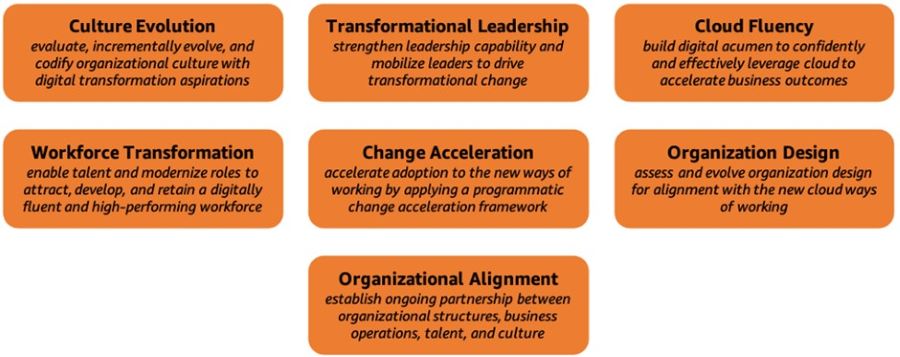As organizations embark on their cloud journeys, it becomes increasingly evident that success lies not only in adopting cutting-edge technologies but also in cultivating a supportive and adaptive culture that empowers employees and aligns with digital transformation aspirations. The People Perspective encompasses seven essential capabilities that contribute to this cultural evolution, organizational structure, leadership, and workforce development. People Perspective: Culture and ChangeThe People Perspective acts as a vital link between technology and business, expediting the cloud journey and enabling organizations to swiftly transition to a culture of continuous growth, learning, and embracing change as the new normal. This perspective encompasses seven key capabilities, as illustrated in the following diagram. Key stakeholders in this perspective include the CIO, COO, CTO, cloud director, and leaders across different functions and the enterprise. Figure 1: AWS CAF People Perspective Capabilities Culture Evolution
Transformational Leadership
Cloud Fluency
Workforce Transformation
Change Acceleration
Organization Design
Organizational Alignment
SummaryThe People Perspective is instrumental in driving successful cloud transformation by nurturing a culture of growth, learning, and change within organizations. By focusing on the key capabilities, organizations can create an environment that empowers their workforce and accelerates their cloud journey. In Part 3, we explored the importance of culture, leadership, workforce development, and organizational alignment. We highlighted the need to evolve organizational culture, strengthen leadership capabilities, build digital acumen, enable workforce transformation, accelerate change adoption, align organization design, and establish organizational alignment. These aspects are vital for organizations seeking to thrive in the cloud era. Join us in Part 4 as we explore the Process Perspective and discover how organizations can drive impactful changes that revolutionize their operations and drive business success in the cloud era.
0 Comments
Leave a Reply. |
AuthorTim Hardwick is a Strategy & Transformation Consultant specialising in Technology Strategy & Enterprise Architecture Archives
June 2023
Categories
All
|
Site powered by Weebly. Managed by iPage



